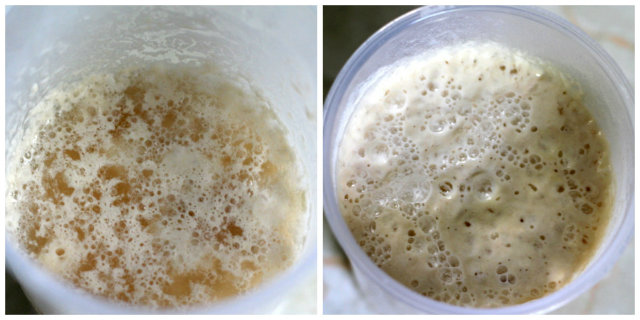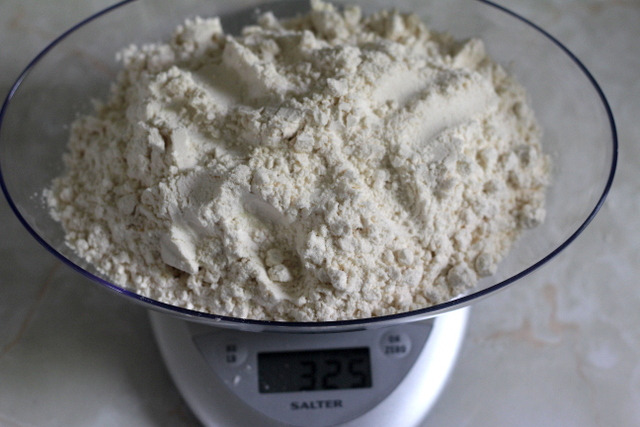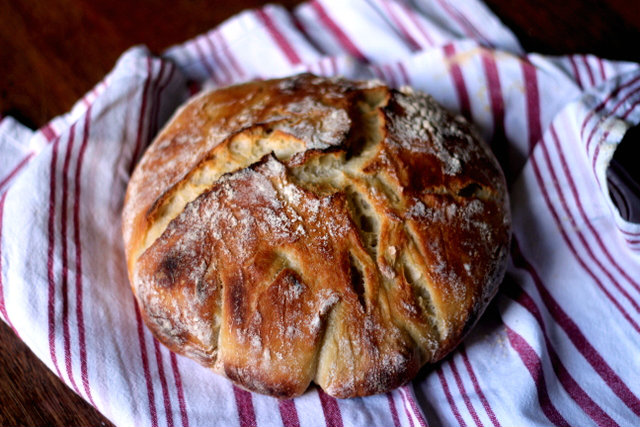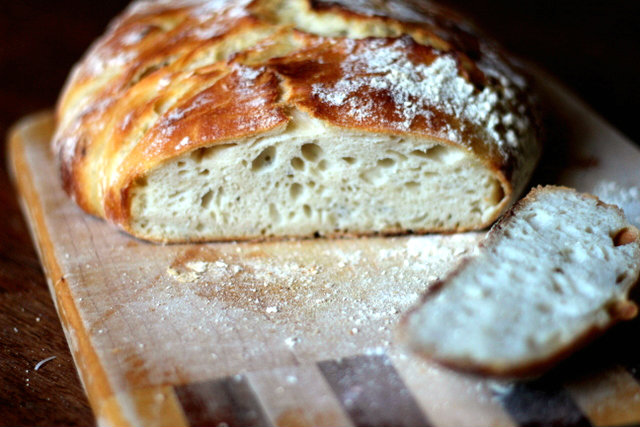I have been wanting to make sourdough bread for awhile now. When I first started to do some research into making my own sourdough, I must admit I felt a little discouraged at how incredibly complex and difficult it all sounded. The process of both making the starter and then the bread itself came with dozens of guidelines and rules – the water must be filtered, the starter must “grow” in a warm room, and the bread must be cooked in a very hot oven. I must admit that I felt a little discouraged, and went and bought a loaf from the shop instead.
The night that I finally decided to bite the bullet and make my sourdough starter, all I had on hand was the flour. Should I run to the shop to buy bottled water? It was 9pm at night and I was already in my comfy “home” clothes. Plus, it was raining… What would happen if I didn’t use filtered water? Would the starter not ferment? Would it turn straight to glue? Finally, realising that if it didn’t work all I would lose would be 1/2 cup of flour, I set to work and mixed together said flour with an equal part of water in a plastic container* (also a no-no – “its best to use glass”) and sat it on top of the refrigerator, partly because one of the recipes instructed me to, but also because we have a very small kitchen with very little bench space and it was one of the only free nooks in the room.
*Note I have since relocated the started to a glass jar, I just didnt have one clean that night.
Above: Starter day 3, starter day 5
The next day when I went to inspect my starter, fearing the worst, I was pleasantly surprised to find a bubbly flour and water mixture – thats right, my starter had began to ferment! My good luck continued, and low and behold, on the sixth day when I went to make my sourdough, I was presented with a warm, crusty loaf that was crisp on the outside yet soft and spongy in the middle.
I must admit, even though this is not the best sourdough I have ever had – it is pretty damn good! I have since made a second loaf with equally good results, so I decided I had to share this with you. It may not be technically correct, it may not rival the sourdough you ate that one time along the banks of the River Seine, at sunset, the Parisian skyline glistening away in the background – but its definitely as good a starting point as any.
Sourdough starter
Adapted from The Kitchn
Day 1
Mix 1/2 C plain flour with 1/2 cup of water in a clear plastic or glass container until well combined. Cover, and place somewhere warm (eg the top of the refrigerator)
Day 2
Some bubbles should have started to form by the second day, and your starter should be fairly thick and soupy.
Add another 1/2 cup each of water and flour, and mix until well combined.
Day 3
More bubbles should have appeared by the third day and the starter should appear spongier. I had a bit of liquid that formed on mine by day three, this needs to be stirred back in.
Add another 1/2 cup each of water and flour, and mix until well combined.
Day 4
Repeat day 3
Day 5
Your starter should be ready to use now! Remove the amount desired, and add back in another 1/2 cup each of flour and water. Leave a few hours at room temperature, after which the starter can be placed in the fridge, covered, indefinitely – as long as each week you take out a portion to use, and replace it with roughly the same amount of new flour/water, ie you need to feed your starter weekly.
Simple sourdough bread
Adapted from the Stone Soup
325g (11oz) bread flour
200g (8oz) sourdough starter, recipe below
275g (10oz) water
A good pinch of salt
In a large bowl combine all ingredients, cover and leave for 12 – 18 hours at room temperature (overnight is best).
When you are ready to make your bread, preheat the oven to the hottest temperature possible (for me, this was 280C (535F)).
Generously sprinkle a countertop with flour and gently pour the dough out onto the flour. Fold the edges of the dough into the middle to create a round loaf.
Coat a clean tea towel with another generous sprinkle of flour and place the round loaf on the tea towel, rough side down (this will help you to get the dough into the oven pan later on). Cover again to sit for half an hour.
Whilst the dough is resting, place a large ovenproof pan with a lid in the oven to preheat.
After half an hour, remove the pan and sprinkle the base with a little flour. Gently place the dough in the middle of the pan, rough side now facing up – note that the dough will spread and even itself out while cooking.
Put the lid on and bake for half an hour, then remove the lid, reduce heat to 200C (400F) and bake for a further 15 – 20 minutes, until the dough is a nice deep brown colour (but not starting to burn!)
Cool on a wire rack for around half an hour before serving.







This bread looks really nice and crusty. You call it ‘Simple’, I have tried to make the ‘starter’ twice now with no success. The first time it went mouldy and the second time it was too runny on the day I was to make the bread. Any idea on what went wrong?
Thanks x
Wondering what flour to use if you didn’t use white flour?
Hi Bonnie, if you don’t want to use white flour you could sub with any other grain-based flour – wholewheat, rye, spelt etc. I sometimes mix half and half with mine (ie half white, half rye), and usually use wholegrain flours when actually baking the breads. Good luck! :)
I’ve been wanting to try my hand at sourdough but am overwhelmed at the thought of 1) making bread weekly when we don’t usually eat that much, and 2) having something I have to take care of week in and week out. My kefir is generally enough work for me to keep up feeding. ;-) What was your solution for this and how long did you keep your starter going?
Hi Katie! Sorry for the (very!) delayed reply, the last week has been a little hectic! So – in answer to your questions –
1. We don’t really eat that much bread either… it’s possible to stretch out the feeding to once every two weeks, so if you made a loaf every two weeks you could eat some fresh and then slice and freeze the rest to grab a bit and toast throughout the remaining fortnight… Alternatively, you can also use to starter to make things other than breads, eg pancakes, muffins etc. This can be a great alternative to bread and fun to experiment with!
2. I actually used to set a reminder on my phone for every Saturday mid-morning to water the house plants and feed the starter! It became part of my usual Saturday morning ritual, and once you are in the habit of doing it, and knowing you’ll be rewarded with freshly baked bread, it doesn’t seem like that much of a chore anymore :)
Hi, can I use sour dough in bread maker?
Hi Jane. I don’t have a bread maker myself so have not tried this and really cannot say. I think it would depend a lot on your machine and would be a good idea to refer to the user manual if you still have it. There is more information here – http://www.culturesforhealth.com/using-bread-machine-make-sourdough
Thanks for the useful link.